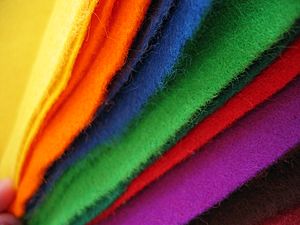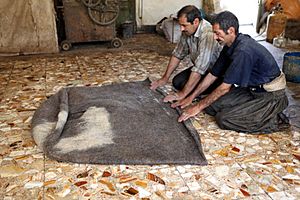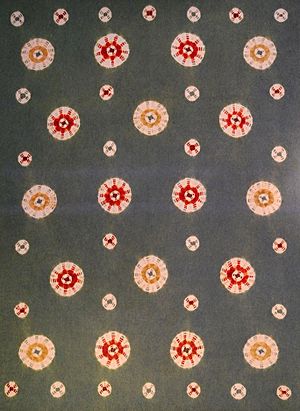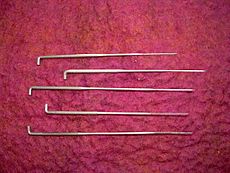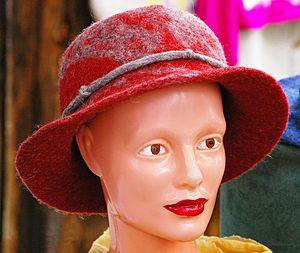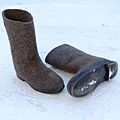Felt facts for kids
Felt is a type of cloth that is made by matting wool fibers, either with water and soap, or by poking the fibers with barbed needles. Felt can be made by hand, or by machine.
People have been making felt longer than any other kind of fabric. Felt can be of any color, and made into any shape or size. Felt is used to make many things like clothing, hats, and rugs. Nomadic people in many countries live in tents made of felt. Felt is used for many different things. Today people use felt for hat-making, insulating (making warm), sound-proofing, and cushioning.
Contents
Felt versus fabric
The difference between felt and most fabrics, like denim, is that most fabrics have a regular criss-cross, in-and-out weaving pattern, but felt is a messy jumble of threads. Most fabrics are woven for strength and smoothness: they need carding to straighten the fibers, spinning to turn fibers into long threads and weaving to make fabric. Felt only needs a carding comb. Because of this, felt was often used by nomadic people.
Manufacturing methods
Wet felting
In the wet felting process, hot water is applied to layers of animal hairs, while repeated agitation and compression causes the fibers to hook together or weave together into a single piece of fabric. Wrapping the properly arranged fiber in a sturdy, textured material, such as a bamboo mat or burlap, will speed up the felting process. The felted material may be finished by fulling.
Needle felting
Needle felting is a method of creating felt that uses specially designed needles instead of water. Felting needles have angled notches along the shaft that catch fibers and tangle them together to produce felt. Felting needles are thin and sharp, with shafts of a variety of different gauges and shapes. Needle felting is used in industrial felt making as well as for individual art and craft applications.
Carroting
Invented in the mid 17th century and used until the mid-20th centuries, a process called "carroting" was used in the manufacture of good quality felt for making men's hats. Beaver, rabbit or hare skins were treated with a dilute solution of the mercury compound mercuric nitrate. The skins were dried in an oven where the thin fur at the sides turned orange, the color of carrots. Pelts were stretched over a bar in a cutting machine, and the skin was sliced off in thin shreds, with the fleece coming away entirely. The fur was blown onto a cone-shaped colander and then treated with hot water to consolidate it. The cone then peeled off and passed through wet rollers to cause the fur to felt. These 'hoods' were then dyed and blocked to make hats. The toxic solutions from the carrot and the vapours it produced resulted in widespread cases of mercury poisoning among hatters. This may be the origin of the phrase "mad as a hatter" which was used to humorous effect by Lewis Carroll in the chapter "A Mad Tea Party" of the novel Alice in Wonderland.
Uses
Felt is used in a wide range of industries and manufacturing processes, from the automotive industry and casinos to musical instruments and home construction.
Felt in musical instruments
Many musical instruments use felt. It is often used as a damper. On drum cymbal stands, it protects the cymbal from cracking and ensures a clean sound. It is used to wrap bass drum strikers and timpani mallets. Felt is used extensively in pianos; for example, piano hammers are made of wool felt around a wooden core. The density and springiness of the felt is a major part of what creates a piano's tone. As the felt becomes grooved and "packed" with use and age, the tone suffers. Felt is placed under the piano keys on accordions to control touch and key noise; it is also used on the pallets to silence notes not sounded by preventing air flow.
Industrial uses
Felt is frequently used in industry as a sound or vibration damper, and in machinery for cushioning and padding moving parts.
Felt in arts and crafts
Felt is used for framing paintings. It is laid between the slip mount and picture as a protective measure to avoid damage from rubbing to the edge of the painting. This is commonly found as a preventive measure on paintings which have already been restored or professionally framed. It is widely used to protect paintings executed on various surfaces including canvas, wood panel and copper plate.
A felt-covered board can be used in storytelling to small children. Small felt cutouts or figures of animals, people, or other objects will adhere to a felt board, and in the process of telling the story, the storyteller also acts it out on the board with the animals or people. Puppets can also be made with felt. Felt pressed dolls, such as Lenci dolls, were very popular in the nineteenth century and just after the first world war.
Felt in art and design
German artist Josef Beuys used felt in a number of works and many more people.
Felt in fashion
During the 18th and 19th centuries gentlemen's top hats made from beaver felt were popular. In the early part of the 20th century, cloth felt hats, such as fedoras, trilbies and homburgs, were worn by many men in the western world. Felt is often used in footwear as boot liners, with the Russian valenki being an example.
Interesting facts about felt
- Felt's origins can be traced back to Siberia and Mongolia.
- In nomadic peoples, felt was often featured in the blankets that went under saddles.
- Sumerian legend claims that the secret of feltmaking was discovered by Urnamman of Lagash.
- The story of Saint Clement and Saint Christopher relates that the men packed their sandals with wool to prevent blisters while fleeing from persecution. At the end of their journey, the movement and sweat had turned the wool into felt socks.
Images for kids
See also
 In Spanish: Fieltro para niños
In Spanish: Fieltro para niños


